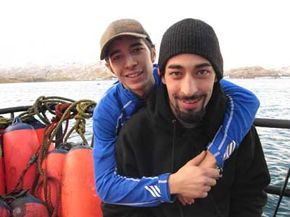Wanted: Crew members for dangerous deep-sea crabbing. Location: The middle of an icy ocean. Description: Endure merciless hazing by fellow crewmen; work 15 hours or more a day, seven days a week; risk your life; get paid only half of what everyone else gets paid on the boat.
Interested?
Advertisement
Believe it or not, each year, people fight tooth and nail to land this position. Why? Because as brutal as the work is, the pay can be handsome. Crew members on a crab fishing boat can earn up to $15,000 in one month [source: Alaska Fishing Jobs]. Unfortunately, as with any career, before you earn top dollars, you have to start at the bottom. Entry-level crabbers are called "greenhorns," and you'll find at least one on every crab boat.
To understand what a greenhorn is, let's first take a look at the meaning of the word. Originally, a greenhorn referred to an animal with green (or young) horns. By the mid-1600s, a greenhorn referred to a newly enlisted soldier. Then, in the 1830s, the word came to describe a very inexperienced person or a novice in a particular trade [source: Safire]. That last definition aptly describes the crab fishing greenhorn.
On a crab boat, a greenhorn is a newbie who may or may not have previous fishing experience. A greenhorn could be completely new to the fishing industry, or he or she could be several seasons in -- still learning the ropes on a particular boat. Commercial crab fishing is punishing and dangerous work, and many greenhorns quit after the first trip. To learn more about the work, read Why was Alaskan fishing named the most dangerous job in the world?.
We're not exaggerating about the difficulty of a greenhorn's job. In season two of the TV show "Deadliest Catch," the conditions on the Aleutian Ballad pushed the boat's greenhorn to his breaking point. Desperate to escape the vessel, Lysander Smith threatened to jump into the frigid water -- which would have meant certain death -- claiming he'd wait for the Coast Guard to rescue him. The ship had to make an unscheduled stop to return Smith to the harbor and pick up a fresh greenhorn. Smith's meltdown caused the Aleutian Ballad to lose hours of valuable fishing time. On dry land, Smith admitted that the job was simply more than he could handle.
Crab fishing is not for the weak of spirit.
Advertisement



